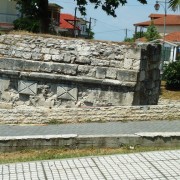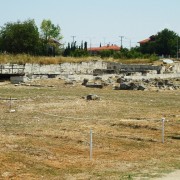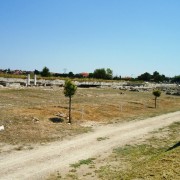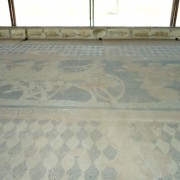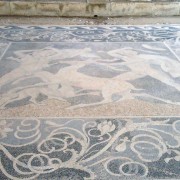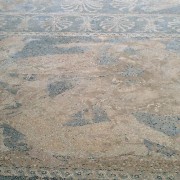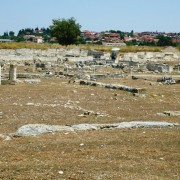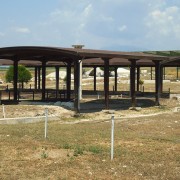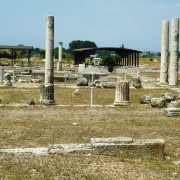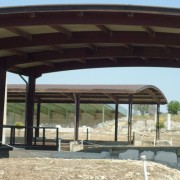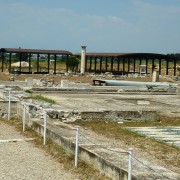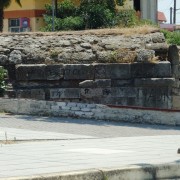Pella, the ancient city of Macedonia.
History
The city was founded by Archelaus I “(413-399 BC.) Or by Amyntas III” to become the new capital of the Macedonian state instead of Goats (Vergina). Pella remained the capital until the overthrow of the Macedonian state by the Romans who pillaged and brought the treasures of Rome. Later the town was destroyed by an earthquake and then rebuilt. Around 180 AD Lucian informs us that “it is no longer negligible and with few inhabitants.”
The earliest reference we have to Pella is by Herodotus in describing the Persian campaign and by Thucydides in the description of the Macedonian expansion and the war against Sitalkis, king of the Thracians. According to Xenophon, in the beginning of the 4th century BC was the largest city in Macedonia. The city attracted famous artists of the era, such as the painter Link, the poet Timotheus of Miletus and Euripides, who died there writing tragedy Archelaus. After the violent death of Archelaus the development of the state stopped. His great work was continued after a few decades of Philip II “(360-336 BC). The attempt of Philip was not only limited to domestic development, but focused mainly on expanding political power of Macedonia. During those years, Pella reaches full edge, is “the greatest of cities in Macedonia” (Xenophon Greek V, 2,13) and radiation spreading across the known world by the conquests of Alexander III (336-323 BC) After the death of Alexander the endless conflicts erupt between his successors, until the rise to the throne of Antigonus Gonatas (276-239 BC). Pella veteran Alexander the Great founded the homonymous Decapolis colony in Palestine, in the hinterland of Syria another Pella and the Persian Gulf Pellaio the municipality. During the period of Antigonus Gonatas, the city reached the edge (according to archaeological findings).
Pella later referred to by Polybius and Livy as the seat of the kingdom of Philip V “and Perseus of Macedon during the Macedonian wars. The Livy gives us the only description of the city as he saw the Roman Lucius Aemilius Paulus the Macedonian, winner of the Battle of Pydna:
“… And he saw that it was chosen as the site remained the royal residence. It is located on the southwestern slope of a hill and surrounded by marsh too deep to be crossed on foot in summer and winter. The citadel, which is near the city, inside the swamp and protruding like an island, is not built on foundations that withstand giant walls over and protect against intrusion of lake water. From a distance it seems like a continuation of the city wall, but in reality is separate and between the two there is a channel walls. The citadel connects with the city by a bridge, so cut all sides access an external enemy and if the king imprison someone there no way of escape except by the bridge, which is easily stored. ”
In the Roman province of Macedonia, Pella was the capital of the third district and probably the seat of the Roman governor. From Pella passed the Ancient Via Egnatia and was an important station between Dyrracheiou and Thessaloniki. Cicero stayed there in 58 BC, but the position of prefect at that time had moved to Thessaloniki.
The city fell into decline for reasons unknown (probably due to the earthquake) to the end of the 1st BC century.
Οld Pella
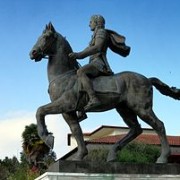 The City of Pella
The City of Pella
Pella was recognized as a community on June 28, 1918 [1] under the name “Holy Apostles”, and consisting of the settlements RAHONI, Leivaditsas and Agrosykia. The last two were detached from Pella in 1922 and annexed the community playthings.
On March 2, 1926 renamed “Old Pella” [2]. To 1975 named “Pella”.
The municipality was upgraded to a municipality in 1989, for historical reasons, by Presidential Decree 592/21-12-1989 [3].
With Kapodistrias plan, the City of Pella is expanding and includes the communities hitherto Nea Pella, playthings, West, and Agrosykia RAHONI with the settlement of Leivaditsas. The draft Kallikratis the Municipality further extended and merged with the municipalities Yannitsa, Cyrrhus, cold tap and Alexander the Great and the headquarters moved Yannitsa. So the City of Pella today is the most populated of the county has more than 63,122 residents.
